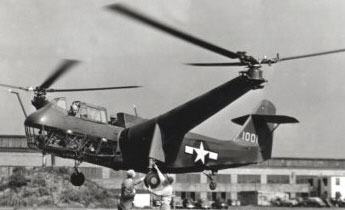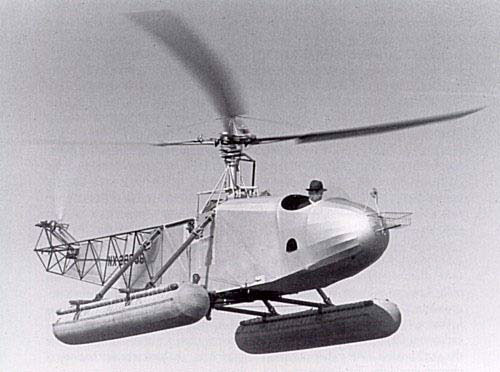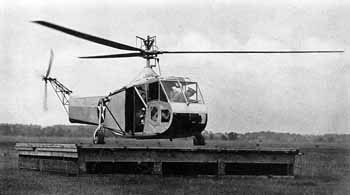Starting in 1909 a series of attempts at vertical flight was conducted. The concept was feasible but the technology had a long way to go before any significant advances could be made. Apart from the lack of a suitable engine, powerful, and light enough to enable a helicopter to lift more than its own weight, the principle problem which all the early pioneers encountered was controlling the helicopter. Vertical flight did not really progress until the arrival of the autogiro. Both the Army and the Navy evaluated the military application of a Pitcairn autogiro in the mid thirties but it did not meet their needs. The Navy dismissed the idea of vertical flight but the Army Air Force continued to show interest. The then LT H.F. Gregory, who became the Army’s Rotary Wing Project Officer, remained faithful to his belief that rotary-wing aircraft had great potential for military applications.

In 1937, Professor Heinrich Focke and another German named Achgelis joined forces to conduct helicopter research. The result was the production of the FW-61 based on the fuselage of a small biplane trainer with two outriggers supporting the contra-rotating rotors. The cut-down propeller mounted on the front of the radial engine was used only for cooling. The control was so precise that the machine was demonstrated by Flugkapitan Hanna Reitsch inside the Deutschlandhalle stadium in Berlin.
There were skeptics in the United States but there were also believers. The Platt-

Helicopter
LePage Company had already begun designing a similar machine. The Army was interested in the project but there was no money appropriated for development. Representative Frank Dorsey of Pennsylvania introduced a bill in Congress for funds to develop the autogiro and procure a sufficient number of service tests. The bill passed on June 30, 1938 and was not limited to autogiros. It appropriated $2,000,000 for rotary wing and other aircraft research. An Inter-agency Board, representing all possible government users of rotary-wing aircraft was created to administer the program. Commander William J. Kossler, a strong advocate of the potential of helicopters, was the aviation engineering officer at Coast Guard Headquarters and served as the Coast Guard representative on the board. In 1940 this board, chaired by the U.S. Army, had secured $300,000 of the $2 million appropriated by Congress. It met to consider a proposal by Platt-LePage and Sikorsky who had again become involved in the development of helicopters. Kossler said the Platt-LePage proposal for an experimental helicopter was chosen because it was considered more practical.
Igor Sikorsky did not give up and continued to make impressive progress without government help. By the end of the year the United Aircraft Company (Sikorsky) had sunk $100,000 into the development of Sikorsky’s first experimental helicopter, the VS-300. Unlike most other designers he opted for the Main Rotor plus Tail Rotor configuration. However, Sikorsky was not so much an inventor as a designer who made use of the best of all the currently available designs and melded them together.

The Platt-LePage XR-1 helicopter was experiencing difficulties and did not make its first tethered flight until May 22, 1941. By this time Sikorsky had already tested the VS-300 in tethered flight and established a new International helicopter endurance record. The board, impressed by Sikorsky’s accomplishment met on December 17, 1940 and decided that two helicopters of different design were better than one, but only $50,000 of the appropriations remained unspent. United Aircraft agreed to provide an additional $50,000. Additional funds came later.
The Sikorsky XR-4 flight test program began on January 14, 1942 when the second Sikorsky helicopter lifted off the ground for the first time in free flight. By April, Gregory, now a Lieutenant Colonel, decided that the XR-4 should be demonstrated before the Board. Not all of the Board was present but CDR Kossler who had invited CDR W.A. Burton, Commanding Officer Coast Guard Air Station Brooklyn, to accompany him, witnessed the demonstration. Also present was Wing Commander Reggie Brie, RAF who had been sent to the United States to investigate the potential of helicopters for anti-submarine duty on board British merchant ships. Brie’s support would later be of significant value to Kossler.
Sikorsky Chief Test Pilot Les Morris performed aircraft maneuvers that if they had not been demonstrated would have been considered fictional. The helicopter lifted off the ground about seven feet and then remained in that position. It then settled gently back to earth at the spot it first lifted off. The aircraft was flown forward, sideways, and backward. Morris then flew a twisting course between rows of trees followed by a vertical climb to 500 feet. The helicopter pitot tube extended out in front of the aircraft. A Sikorsky employee, using a pole, held aloft a ring about 10 inches in diameter and Morris flew the probe into the ring and lifted it off the pole. The helicopter was hovered at 25 feet and a man climbed up a lowered rope ladder. He pulled the ladder in after him and the helicopter flew away. Morris followed this with an intentional power off approach from a 2000 foot altitude to a perfect landing. (Autorotation)
Since the beginnings of Coast Guard aviation the concept of a “flying life boat” for air rescue work was pursued. The aircraft chosen were lightweight, landing and takeoff speeds were low, and the distances required across the surface of the sea was short. Successful open-sea landings became common – so did crashes. The frequency of these crashes prompted a request by the Commandant that each aviator submit suggestions for developing safe procedures for open-sea rescues by airplane. The danger in these operations became a deep concern for CDR Kossler and a young aviator by the name of Frank Erickson who had worked on developing methods for aerial delivery of survival equipment without the necessity of landing in the open sea. After witnessing the Sikorsky demonstration Kossler had found his answer. He was so impressed that he would dedicate the rest of his life to achieving a Coast Guard aviation organization built around the rescue helicopter.
The demonstration caused great excitement in all that viewed it. Kossler, openly enthusiastic, wrote a report to the Commandant pointing out the many advantages of using the helicopter for rescue work. CDR. P.A. Leamy, Aviation Operations Officer was impressed and advocated the purchase of several helicopters for training and experimental development. Kossler thought that three should be purchased for $250,000, but neither the Coast Guard’s Engineer-in-Chief, Rear Admiral Harvey Johnson nor the Assistant Commandant, Rear Admiral Lloyd Chalker were in favor of the purchase. Chalker, in 1939, had attended a conference that set performance criteria for rotary-winged aircraft. Due to lack of real data the committee established parameters that mirrored general requirements for fixed wing aircraft of this period. This most probably influenced his reasoning. The reasons cited for disapproval were that the cost of acquisition was too great for the limited performance capabilities of the aircraft and the helicopter was not essential to the war effort. Kossler was told; “Hell, Bill, the Navy isn’t interested in life saving; all they want to do is get on with the business of killing the enemy.” Without the support of these two officers- next in rank to the commandant- the future for Coast Guard helicopters looked bleak. Kossler was upset with the reception his helicopter proposal received but he remained undaunted. Over the next several months he would orchestrate a series of events which would lead to the Coast Guard’s involvement with the helicopter. The emphasis would be placed on a machine that had the capability “to get on with the business of killing the enemy.”
The German submarines were extracting extraordinary losses. Surprisingly it was the Army Air Force that recognized the helicopter might have a potential as an antisubmarine weapon. The Army was already flying antisubmarine patrols using fixed-wing aircraft and Gregory, speculating that the helicopter could be an extension of this mission, began experimental development with the XR-4. Kossler, aware of this, discussed the situation with LCDR Frank Erickson and enlisted him as part of the team. Erickson was the Executive Officer at Coast Guard Air Station Brooklyn. Burton was the Commanding Officer and had been favorably impressed with a helicopter demonstration. CGAS Brooklyn would make be an ideal location to develop and evaluate the helicopter. Several days later LT. Bill Healy, Kossler’s assistant, arrived at the air station and during lunch he asked if someone could fly him to Bridgeport for an appointment with Igor Sikorsky. Erickson quickly volunteered. Erickson spent hours with Sikorsky and his Chief Engineer, Michael Gluharoff, discussing possible uses for the helicopter. He witnessed a convincing demonstration of the VS-300 which including repeated landings within an inch or two of a given point. This was an important factor if the aircraft was to be operated from a small platform on board ships in rough water.

Erickson put together a proposal to Headquarters. Fully aware of Kossler’s setback in his proposal of the helicopter as a rescue aircraft, he stressed the use of the helicopter as an anti-submarine weapon to operate from vessels in convoys. In the proposal he pointed out specifics. He said that a 30-foot square platform would be needed on ships that would carry helicopters. He further stated that the XR-4 could give greater protection for a convoy than a similar number of blimps or airplanes. With a crew of two and a 325 pound depth charge on board the helicopter could scout for enemy submarines at a speed of 25 to 60 miles per hour for up to four hours per sortie. A top speed of 100 miles per hour could be obtained when desired. Additionally he suggested an arrangement for rescuing survivors of torpedoed ships. He also pointed out that the British were switching from the autogiro to the helicopter for anti-submarine protection. This was based on the recommendation of Wing Commander Brie who had witnessed the XR-4 demonstration. CDR Burton strongly endorsed Erickson’s proposal alluding to the fact that the Coast Guard was actively engaged in this type of warfare. CDR Burton’s endorsement pointed out:
“The Army has demonstrated its belief in the value of the helicopter by contracting for a number of present models. Unfortunately the Navy has not shown any great enthusiasm for this type aircraft. It is therefore an excellent opportunity for the Coast Guard, with a very modest appropriation, to initiate and proceed with the naval development of the helicopter.”
Erickson’s proposal arrived in Headquarters in early July, 1942 immediately after one of the most disastrous months in the anti-submarine war. During June, 55 U.S. Merchant ships comprising a cumulative total of 289,790 tons or more than 4% of the total U.S. tonnage had been sunk. Kossler’s endorsement advised haste knowing the Army planned on completing a six month test program and return the XR-4s to Sikorsky. This time the helicopter proposal was given serious consideration. Appearing at the bottom of Kosslers endorsement is a handwritten note: “I concur. HFJ (Harvey F. Johnson, Engineer-in-Chief USCG). Kossler had his support. Kossler suggested that the British, who were procuring helicopters under lend lease, might turn a few helicopters over to the Coast Guard if requested. On July 24,1942, the Navy Bureau of Aeronautics ordered four helicopters – one YR-4, similar to the XR-4 (Navy designation HNS) and three XR-6s (a later model that would become the XHOS).
The Commander Coast Guard Forces, Third Naval District, Rear Admiral Stanley V. Parker, a World War I aviator, still very interested in aviation, let it be known that he would like to see the VS-300. He and Kossler flew to the Vought-Sikorsky plant at Stratford, Connecticut on December 21. Dr. Igor Sikorsky was delighted. It was his first opportunity to show his helicopter to an officer of flag rank. RADM Parker was also a former dirigible pilot. He was forward thinking and had requested his training in LTA aircraft when going through flight training. He also required it of those pilots going through training at the time of the first Coast Guard air station on the premise that it might prove valuable to Coast Guard search and rescue efforts. He was converted to the helicopter that day by a pull-out-all-stops demonstration by both Sikorsky and Les Morris.
RADM Parker wrote to the commandant:
“Kossler and I saw the Sikorsky helicopter fly at Bridgeport. It was a remarkable thing, capable of flying forward, sideways, and astern. Its control is unbelievable. It landed on a roof of a small building, on top of a pile of aircraft engine cases, on the water, and flew abreast at the same speed as a tug boat. A couple of these with each convoy might give a degree of protection which might be decisive. A new model is being developed. Might not the Coast Guard be given the job of showing its application to convoy protection? Kossler can tell you all about it. Maybe we can get the Coast Guard on the wagon.”
As a result of Parkers comments, ADM Waesche, the Coast Guard Commandant, decided to go to Bridgeport. He and several high ranking officers arrived at Bridgeport on February 13, 1943. They were greeted by Igor Sikorsky and Michael Gluharoff. During the demonstration, Sikorsky flew the VS-300 while Morris flew the XR-4. Two helicopters, performing precision maneuvers, impressively showed their potential for anti-submarine warfare. ADM Waesche was completely “sold.” He conferred with CNO, ADM King, who then issued a directive placing upon the Coast Guard the responsibility for developing the sea-going helicopter. Kossler had the beginnings of his program, the support of his superior and a direct conduit to the Commandant.
This project and the subsequent development of the helicopter laid the groundwork for the extensive Navy and Marine Corps helicopter programs that followed.
